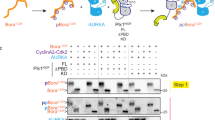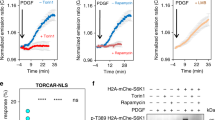Abstract
Akt, also known as protein kinase B, has a central role in various signaling pathways that regulate cellular processes such as metabolism, proliferation and survival. On stimulation, phosphorylation of the activation loop (A-loop) and hydrophobic motif (HM) of Akt by the kinase phosphoinositide-dependent kinase 1 (PDK1) and the mammalian target of rapamycin complex 2 (mTORC2), respectively, results in Akt activation. A well-conserved threonine in the turn motif (TM) is also constitutively phosphorylated by mTORC2 and contributes to the stability of Akt. The role of TM phosphorylation in HM and A-loop phosphorylation has not been sufficiently evaluated. Using starfish oocytes as a model system, this study provides the first evidence that TM phosphorylation has a negative role in A-loop phosphorylation. In this system, the maturation-inducing hormone, 1-methyladenine, stimulates Akt to reinitiate meiosis through activation of cyclin B-Cdc2. The phosphorylation status of Akt was monitored via introduction of exogenous human Akt (hAkt) in starfish oocytes. TM and HM phosphorylation was inhibited by microinjection of an anti-starfish TOR antibody, but not by rapamycin treatment, suggesting that both phosphorylation events depend on TORC2, as reported in mammalian cells. A single or double alanine substitution at each of three phosphorylation residues revealed that TM phosphorylation renders Akt susceptible to dephosphorylation on the A-loop. When A-loop phosphatase was inhibited by okadaic acid (OA), TM phosphorylation still reduced A-loop phosphorylation, suggesting that the effect is caused at least partially through reduction of sensitivity to PDK1. Negative regulation by TM phosphorylation was also observed in constitutively active Akt and was functionally reflected in meiosis resumption. By contrast, HM phosphorylation enhanced A-loop phosphorylation and achieved full activation of Akt via a mechanism at least partially independent of TM phosphorylation. These observations provide new insight into the mechanism controlling Akt phosphorylation in the cell.
This is a preview of subscription content, access via your institution
Access options
Subscribe to this journal
Receive 50 print issues and online access
$259.00 per year
only $5.18 per issue
Buy this article
- Purchase on Springer Link
- Instant access to full article PDF
Prices may be subject to local taxes which are calculated during checkout








Similar content being viewed by others
References
Alessi DR, Andjelkovic M, Caudwell B, Cron P, Morrice N, Cohen P et al. (1996). Mechanism of activation of protein kinase B by insulin and IGF-1. EMBO J 15: 6541–6551.
Alessi DR, Deak M, Casamayor A, Caudwell FB, Morrice N, Norman DG et al. (1997a). 3-Phosphoinositide-dependent protein kinase-1 (PDK1): structural and functional homology with the Drosophila DSTPK61 kinase. Curr Biol 7: 776–789.
Alessi DR, James SR, Downes CP, Holmes AB, Gaffney PR, Reese CB et al. (1997b). Characterization of a 3-phosphoinositide-dependent protein kinase which phosphorylates and activates protein kinase Balpha. Curr Biol 7: 261–269.
Andjelković M, Jakubowicz T, Cron P, Ming XF, Han JW, Hemmings BA . (1996). Activation and phosphorylation of a pleckstrin homology domain containing protein kinase (RAC-PK/PKB) promoted by serum and protein phosphatase inhibitors. Proc Natl Acad Sci USA 93: 5699–5704.
Basso AD, Solit DB, Chiosis G, Giri B, Tsichlis P, Rosen N . (2002). Akt forms an intracellular complex with heat shock protein 90 (Hsp90) and Cdc37 and is destabilized by inhibitors of Hsp90 function. J Biol Chem 277: 39858–39866.
Bhaskar PT, Hay N . (2007). The two TORCs and Akt. Dev Cell 12: 487–502.
Borgatti P, Martelli AM, Tabellini G, Bellacosa A, Capitani S, Neri LM . (2003). Threonine 308 phosphorylated form of Akt translocates to the nucleus of PC12 cells under nerve growth factor stimulation and associates with the nuclear matrix protein nucleolin. J Cell Physiol 196: 79–88.
Brunn GJ, Hudson CC, Sekulić A, Williams JM, Hosoi H, Houghton PJ et al. (1997). Phosphorylation of the translational repressor PHAS-I by the mammalian target of rapamycin. Science 277: 99–101.
Chiba K, Kontani K, Tadenuma H, Katada T, Hoshi M . (1993). Induction of starfish oocyte maturation by the beta gamma subunit of starfish G protein and possible existence of the subsequent effector in cytoplasm. Mol Biol Cell 4: 1027–1034.
Du K, Herzig S, Kulkarni RN, Montminy M . (2003). TRB3: a tribbles homolog that inhibits Akt/PKB activation by insulin in liver. Science 300: 1574–1577.
Du K, Tsichlis PN . (2005). Regulation of the Akt kinase by interacting proteins. Oncogene 24: 7401–7409.
Facchinetti V, Ouyang W, Wei H, Soto N, Lazorchak A, Gould C et al. (2008). The mammalian target of rapamycin complex 2 controls folding and stability of Akt and protein kinase C. EMBO J 27: 1932–1943.
Fayard E, Tintignac LA, Baudry A, Hemmings BA . (2005). Protein kinase B/Akt at a glance. J Cell Sci 118: 5675–5678.
Feldman ME, Apsel B, Uotila A, Loewith R, Knight ZA, Ruggero D et al. (2009). Active-site inhibitors of mTOR target rapamycin-resistant outputs of mTORC1 and mTORC2. PLoS Biol 7: e38.
García-Martínez JM, Moran J, Clarke RG, Gray A, Cosulich SC, Chresta CM et al. (2009). Ku-0063794 is a specific inhibitor of the mammalian target of rapamycin (mTOR). Biochem J 421: 29–42.
Goren I, Müller E, Pfeilschifter J, Frank S . (2008). Thr308 determines Akt1 nuclear localization in insulin-stimulated keratinocytes. Biochem Biophys Res Commun 372: 103–107.
Guerrier P, Doree M . (1975). Hormonal control of reinitiation of meiosis in starfish. The requirement of 1-methyladenine during nuclear maturation. Dev Biol 47: 341–348.
Guertin DA, Stevens DM, Thoreen CC, Burds AA, Kalaany NY, Moffat J et al. (2006). Ablation in mice of the mTORC components raptor, rictor, or mLST8 reveals that mTORC2 is required for signaling to Akt-FOXO and PKCalpha, but not S6K1. Dev Cell 11: 859–871.
Hara M, Mori M, Wada T, Tachibana K, Kishimoto T . (2009). Start of the embryonic cell cycle is dually locked in unfertilized starfish eggs. Development 136: 1687–1696.
Hauge C, Antal TL, Hirschberg D, Doehn U, Thorup K, Idrissova L et al. (2007). Mechanism for activation of the growth factor-activated AGC kinases by turn motif phosphorylation. EMBO J 26: 2251–2261.
Higuchi M, Onishi K, Kikuchi C, Gotoh Y . (2008). Scaffolding function of PAK in the PDK1-Akt pathway. Nat Cell Biol 10: 1356–1364.
Hill MM, Andjelkovic M, Brazil DP, Ferrari S, Fabbro D, Hemmings BA . (2001). Insulin-stimulated protein kinase B phosphorylation on Ser-473 is independent of its activity and occurs through a staurosporine-insensitive kinase. J Biol Chem 276: 25643–25646.
Hiraoka D, Hori-Oshima S, Fukuhara T, Tachibana K, Okumura E, Kishimoto T . (2004). PDK1 is required for the hormonal signaling pathway leading to meiotic resumption in starfish oocytes. Dev Biol 276: 330–336.
Ikenoue T, Inoki K, Yang Q, Zhou X, Guan KL . (2008). Essential function of TORC2 in PKC and Akt turn motif phosphorylation, maturation and signalling. EMBO J 27: 1919–1931.
Jacinto E, Facchinetti V, Liu D, Soto N, Wei S, Jung SY et al. (2006). SIN1/MIP1 maintains rictor-mTOR complex integrity and regulates Akt phosphorylation and substrate specificity. Cell 127: 125–137.
Jaffe LA, Gallo CJ, Lee RH, Ho YK, Jones TL . (1993). Oocyte maturation in starfish is mediated by the beta gamma-subunit complex of a G-protein. J Cell Biol 121: 775–783.
Jiang T, Qiu Y . (2003). Interaction between Src and a C-terminal proline-rich motif of Akt is required for Akt activation. J Biol Chem 278: 15789–15793.
Kalous J, Solc P, Baran V, Kubelka M, Schultz RM, Motlik J . (2006). PKB/AKT is involved in resumption of meiosis in mouse oocytes. Biol Cell 98: 111–123.
Kanatani H, Shirai H, Nakanishi K, Kurokawa T . (1969). Isolation and indentification on meiosis inducing substance in starfish Asterias amurensis. Nature 221: 273–274.
Kishimoto T . (1986). Microinjection and cytoplasmic transfer in starfish oocytes. Methods Cell Biol 27: 379–394.
Kishimoto T . (2003). Cell-cycle control during meiotic maturation. Curr Opin Cell Biol 15: 654–663.
Kohn AD, Takeuchi F, Roth RA . (1996). Akt, a pleckstrin homology domain containing kinase, is activated primarily by phosphorylation. J Biol Chem 271: 21920–21926.
Kuo YC, Huang KY, Yang CH, Yang YS, Lee WY, Chiang CW . (2008). Regulation of phosphorylation of Thr-308 of Akt, cell proliferation, and survival by the B55alpha regulatory subunit targeting of the protein phosphatase 2A holoenzyme to Akt. J Biol Chem 283: 1882–1892.
Lin TA, Kong X, Haystead TA, Pause A, Belsham G, Sonenberg N et al. (1994). PHAS-I as a link between mitogen-activated protein kinase and translation initiation. Science 266: 653–656.
Ma XM, Blenis J . (2009). Molecular mechanisms of mTOR-mediated translational control. Nat Rev Mol Cell Biol 10: 307–318.
Manning BD, Cantley LC . (2007). AKT/PKB signaling: navigating downstream. Cell 129: 1261–1274.
Okumura E, Fukuhara T, Yoshida H, Hanada Si S, Kozutsumi R, Mori M et al. (2002). Akt inhibits Myt1 in the signalling pathway that leads to meiotic G2/M-phase transition. Nat Cell Biol 4: 111–116.
Pause A, Belsham GJ, Gingras AC, Donzé O, Lin TA, Lawrence S . (1994). Insulin-dependent stimulation of protein synthesis by phosphorylation of a regulator of 5′-cap function. Nature 371: 762–767.
Restuccia DF, Hemmings BA . (2010). From man to mouse and back again: advances in defining tumor AKTivities in vivo. Dis Model Mech 3: 705–720.
Sadler KC, Ruderman JV . (1998). Components of the signaling pathway linking the 1-methyladenine receptor to MPF activation and maturation in starfish oocytes. Dev Biol 197: 25–38.
Sarbassov DD, Ali SM, Sengupta S, Sheen JH, Hsu PP, Bagley AF et al. (2006). Prolonged rapamycin treatment inhibits mTORC2 assembly and Akt/PKB. Mol Cell 22: 159–168.
Sarbassov DD, Guertin DA, Ali SM, Sabatini DM . (2005). Phosphorylation and regulation of Akt/PKB by the rictor-mTOR complex. Science 307: 1098–1101.
Sato S, Fujita N, Tsuruo T . (2000). Modulation of Akt kinase activity by binding to Hsp90. Proc Natl Acad Sci USA 97: 10832–10837.
Scheid MP, Marignani PA, Woodgett JR . (2002). Multiple phosphoinositide 3-kinase-dependent steps in activation of protein kinase B. Mol Cell Biol 22: 6247–6260.
Toker A, Newton AC . (2000). Akt/protein kinase B is regulated by autophosphorylation at the hypothetical PDK-2 site. J Biol Chem 275: 8271–8274.
Tomek W, Smiljakovic T . (2005). Activation of Akt (protein kinase B) stimulates metaphase I to metaphase II transition in bovine oocytes. Reproduction 130: 423–430.
Ugi S, Imamura T, Maegawa H, Egawa K, Yoshizaki T, Shi K et al. (2004). Protein phosphatase 2A negatively regulates insulin′s metabolic signaling pathway by inhibiting Akt (protein kinase B) activity in 3T3-L1 adipocytes. Mol Cell Biol 24: 8778–8789.
Acknowledgements
We thank Dr Mark Terasaki for the gift of the pSP64-S vector and Dr Masatoshi Hara for suggestion of eIF4E and 4E-BP1. This work was supported by grants from the Ministry of Education, Science and Culture, Japan to TK.
Author information
Authors and Affiliations
Corresponding author
Ethics declarations
Competing interests
The authors declare no conflict of interest.
Additional information
Supplementary Information accompanies the paper on the Oncogene website
Supplementary information
Rights and permissions
About this article
Cite this article
Hiraoka, D., Okumura, E. & Kishimoto, T. Turn motif phosphorylation negatively regulates activation loop phosphorylation in Akt. Oncogene 30, 4487–4497 (2011). https://doi.org/10.1038/onc.2011.155
Received:
Revised:
Accepted:
Published:
Issue Date:
DOI: https://doi.org/10.1038/onc.2011.155



